 |
| The Parable of the Laborers in the Vineyard From the Codex Aureus of Echternach German (Echternach), c. 1030-1050 Nuremberg, Germanisches Nationalmuseum MS Hs 156 142, fol. 76v |
“Jesus told his disciples
this parable:
"The kingdom of heaven is like a landowner
who went out at dawn to hire laborers for his
vineyard.
After agreeing with them for the usual daily
wage,
he sent them into his vineyard.
Going out about nine o'clock,
the landowner saw others standing idle in the
marketplace,
and he said to them, 'You too go into my
vineyard,
and I will give you what is just.'
So they went off.
And he went out again around noon,
and around three o'clock, and did likewise.
Going out about five o'clock,
the landowner found others standing around, and
said to them,
'Why do you stand here idle all day?'
They answered, 'Because no one has hired us.'
He said to them, 'You too go into my vineyard.'
When it was evening the owner of the vineyard
said to his foreman,
'Summon the laborers and give them their pay,
beginning with the last and ending with the
first.'
When those who had started about five o'clock
came,
each received the usual daily wage.
So when the first came, they thought that they
would receive more,
but each of them also got the usual wage.
And on receiving it they grumbled against the
landowner, saying,
'These last ones worked only one hour,
and you have made them equal to us,
who bore the day's burden and the heat.'
He said to one of them in reply,
'My friend, I am not cheating you.
Did you not agree with me for the usual daily
wage?
Take what is yours and go.
What if I wish to give this last one the same as
you?
Or am I not free to do as I wish with my own
money?
Are you envious because I am generous?'
Thus, the last will be first, and the first will
be last."
Matthew 20:1-16 (Gospel for the
Twenty-fifth Sunday in Ordinary Time)
Human Fairness and God's Justice
This parable of Jesus has always been
difficult for me (and I suspect for many others) to completely accept. The story of the vineyard owner who hires
workers throughout the day and then pays all of them the same amount of money
is a tough one. We, like the workers who
had worked the full day from 5 AM to the evening, feel at least slightly aggrieved. Something is wrong with the situation. It isn’t FAIR!
Fairness is a cherished human
virtue. It is the “level playing field”,
it is the “fair wage for a fair day’s work”, it is “the fairness doctrine” in
politics. We demand that things be
“fair” in our work, in our politics and in society as a whole. “That’s not fair!” is a protest heard
everywhere from the baseball field to the marketplace (whether metaphorical or
actual). “Fair” is a quality most of us strive to maintain in our personal lives
and in our business transactions.
But this parable stands all that on its
head. It is a story told through the
eyes of God himself. And, although
“being fair” sounds like a worthy aspiration, reflecting the divine rule of “do
unto others”, it is not the necessarily the measure that God uses.
More important than “fair” is “justice”
and this is where we trip up. Our
measuring stick for interactions with our fellow humans is primarily fairness,
we try to be even handed in our dealings with others. But God’s nature requires justice and that is
how He measures us. So, in the parable,
it is just, it is “fair” that the workers who worked all day receive no more
than the wage they agreed to when they accepted the employment. Although our human instincts join their
protest against what they consider to be unfair, they are actually getting what
they agreed to. Why? Because the owner of the vineyard wishes to
be generous to those workers who came hired late and only worked for a brief
time.
Of course, the purpose of the parable is
to enlighten us to the point of view of God and Jesus isn’t actually talking
about workers in a vineyard. These are
metaphors for a deeper reality. The
parable begins with the words “the Kingdom of Heaven is like….” and the meaning
is that God decides who will live in that Kingdom. According to the parable those who become reconciled
to God just before their death will receive the same reward as those who
followed Him from their earliest days.
This is God’s justice as well as His mercy.
Indeed, the Mass for the twenty-fifth
Sunday in Ordinary Time makes this point twice.
The first reading, from the Old Testament Book of Isaiah reads:
“Seek the LORD while he may
be found,
call him while he is near.
Let the scoundrel forsake
his way,
and the wicked his thoughts;
let him turn to the LORD for
mercy;
to our God, who is generous
in forgiving.
For my thoughts are not your
thoughts,
nor are your ways my ways,
says the LORD.
As high as the heavens are
above the earth,
so high are my ways above
your ways
and my thoughts above your
thoughts.”
Isaiah 55:6-9
And that, tough and “unfair” as it may
seem to us is a very comforting message about God’s mercy and his justice.
The Parable of the Workers in the Vineyard in Art
The parables as a group are sometimes
not the easiest of the Gospel passages to illustrate and this parable is
particularly difficult. There are
several elements of the story that make it more difficult than most. First, there is the hiring of the workers,
which is spread over the entire day, not easy to represent in one simple image. Then, there is the payment for the workers,
again spread over some time. This is
followed by the complaint of the workers hired in the early morning against the
equal pay offered to those who had worked only one hour and the response of the
owner “Are you envious because I am generous?” (Matthew 20:15) And
lastly, there is the stark reminder of God’s just point of view “the last
will be first, and the first will be last." (Matthew 20:16)
,%20c.%201039-1040_Premen,%20Staats-%20und%20Universitatsbibliothek_MS%20b%2021.jpg) |
| The Parable of the Laborers in the Vineyard From the Gospel Lectionary of Henry III German (Echternach), c. 1039-1040 Bremen, Staats-und-Universitatsbibliothek MS b 21 |
The earliest images of this parable that I could find come from manuscripts painted in the Ottonian period. This is a period which follows the Carolingian renaissance of the eighth and ninth centuries. These manuscripts were painted in the scriptoria of German monasteries that were under the patronage of the successors of the Carolingian emperors, such as Echternach and Reichenau. These images make an effort to tell all the parts of the story.
 |
| Benedetto Antelami, The Parable of the Laborers in the Vineyard Italian, c. 1196-1200 Parma, Baptistery |
So does the sculptor Benedetto Antelami and the Master of Edward IV, a manuscript painter of the late fifteenth century.
,%20c.%201487-1490_New%20York,%20Pierpont_MS%20M%20894,%20fol.%2083v.jpg) |
| Master of Edward IV, Parable of the Laborers in the Vineyard From a Vita Christi Flemish (Bruges), c. 1487-1490 New York, Pierpont Morgan Library MS M 894, fol. 83v |
The great precursor of the High Renaissance,
Andrea del Sarto, illustrated two movements of the story, the Hiring of the
Laborers and their Payment in two chiaroscuro frescoes painted between 1510 and
1514 in the monastery garden at the Santissima Annunziata church in
Florence. Unfortunately, these frescoes were
destroyed during the course of the centuries. 1 However, they were
frequently copied and, thus, well known throughout Europe.
 |
| Cornelis Cort After Andrea del Sarto, The Vineyard Owner Hiring Workers Dutch, 1563 Philadelphia, Museum of Art |
 |
| Cesare Roberti After Andrea del Sarto, The Vineyard Owner Hiring Workers Italian, Early 17th Century Philadelphia, Museum of Art |
 |
| Cesare Roberti after Andrea del Sarto, The Vineyard Owner Hiring Workers Italian, c. 161-1650 Madrid, Real Academia de Bellas Artes de San Fernanco |
 |
| Andrea del Sarto, The Vineyard Owner Paying the Workers Italian, c. 1500-1530 Vienna, Albertina Museum |
 |
| Copy after Andrea del Sarto, The Vineyard Owner Paying the Workers Italian, c. 1500-1530 Milan, Pinacoteca di Brera |
 |
| Copy after Andrea del Sarto, The Vineyard Owner Paying the Workers Italian, 16th Century Paris, Musée du Louvre, Département des Arts graphiques |
 |
| Fedrico Zuccaro after Andrea del Sarto, The Vineyard Owner Paying the Workers Italian, c. 1590-1609 Paris, Musée du Louvre, Département des Arts graphiques |
 |
| Peter Paul Rubens after Andrea del Sarto, The Vineyard Owner Paying the Workers Italian, c. 1600 Paris, Musée du Louvre, Département des Arts graphiques |
However, in the main, these efforts to
tell a complete story in one or two images were usually abandoned in favor of
focus on the several actions of the owner represented separately.
Hiring the Workers
These images are the simplest to
understand. The owner of the vineyard
hires men and sends them to his fields.
Most of the images show that other men are already at work in the fields.
 |
| The Vineyard Owner Hires Laborers for the Vineyard From a Leben Jesu Austrian, c. 1425-1435 Vienna, Österreichische Nationalbibliothek MS Cod. 485, fol. 39v |
 |
| Antwerp Master I, The Vineyard Owner Hires Laborers for the Vineyard Flemish, c. 1485-1491 Amsterdam, Rijksmuseum |
 |
| Monogrammist R, The Vineyard Owner Hires Laborers for the Vineyard German, c. 1525-1600 Wolfenbuttel, Herzog August Library |
 |
| Sebald Beham, The Vineyard Owner Hires a Laborer for the Vineyard From a Series of New Testament Illustrations German, 1530 London, Trustees of the British Museum |
 |
| Georg Pencz, The Vineyard Owner Hires Laborers for the Vineyard German, c.1534-1535 Amsterdam, Rijksmuseum |
 |
| Jan Collaert the Younger after Maerten de Vos, The Vineyard Owner Hires a Laborer for the Vineyard Flemish, 1597 Amsterdam, Rijksmuseum |
 |
| Jacob Matham after Pieter Aertsen, Market Scene with the Parable of the Laborers in the Vineyard in the Background Dutch, c. 1600-1603 Amsterdam, Rijksmuseum |
 |
| Attributed to Joachim Govertszoon Camphuysen or Gillis Peeters, The Owner of the Vineyard Hires His Laborers with the City of Antwerp in the Background Dutch, c. 1616-1659 Private Collection |
 |
| Domenico Fetti, The Vineyard Owner Hires a Laborer Italian, c. 1618 Florence, Galleria Palatina, Palazzo Pitti |
 |
| Nicolas Cochin, The Vineyard Owner Hires Laborers for the Vineyard French, c. 1672 Nancy, Musée des Beaux-Arts |
 |
| Sebastien Leclerc, The Vineyard Owner Hires Laborers for the Vineyard Page 26 of Histoire sacree en tableaux, Vol. III French, c. 1675 Dresden, Staatliche Kunstsammlungen, Kupferstich-Kabinett |
 |
| Johann Christian Brand, The Vineyard Owner Hires Laborers for the Vineyard Austrian, 1769 Vienna, Akademie der bildenden Kùnste |
,%20%20Dalarnas%20Museum.jpeg) |
| Winter Carl Hansson, Deorative Wall Painting, The Parable of the Laborers in the Vineyard Swedish, c. 1800 Falun (SE), Dalarnas Museum |
Paying the Workers
The images of payment are a little more
complex. One has to be alert for signs
of dissent among the workers as they receive payment. However, the images which record just payment
being made are numerous.
,%20c.%201350_Oxford,%20The%20Bodleian%20Library_MS%20Douce%20313,%20fol.%2035r.jpg) |
| School of Jean Pucelle, The Vineyard Owner Paying the Workers From a Missal French (Paris), c. 1350 Oxford, The Bodleian Library MS Douce 313, fol. 35r |
 |
| The Vineyard Owner Paying the Workers German, c. 1366-1368 Bremen, Cathedral of Saint Peter |
,%20c.%201419-1437_New%20York,%20Pierpont_MS%20M%20359,%20fol.%2074r.jpg) |
| The Bedford Master and Workshop,The Vineyard Owner Paying Two Workers From a Book of Hours French (Paris), c. 1419-1437 New York, Pierpont Morgan Library MS M 359, fol. 74r |
 |
| Anonymous, The Vineyard Owner Paying a Worker Possibly Dutch, 1536 Amsterdam, Rijksmuseum |
 |
| Bernardino Passeri, Parable of the Workers in the Vineyard, The Owner Pays the Workers Italian, 1593 London, Royal Collection Trust |
 |
| Johannes Wierix after Bernardino Passeri, Parable of the Workers in the Vineyard, The Owner Pays the Workers Flemish, 1593 Amsterdam, Rijksmuseum |
 |
| Lambert Jacobszoon, The Vineyard Owner Paying the Workers Dutch, c. 1625-1630 Besancon, Musée des Beaux-Arts et d'Archeologie de Besancon |
 |
| Rembrandt, The Vineyard Owner Paying Workers Dutch, c. 1637 Saint Petersburg, State Hermitage Museum |
 |
| Circle of Ferdinand Bol, The Vineyard Owner Paying a Worker Dutch, 1650 Frankfurt-am-Main, Städel Museum |
Receiving the Compliant of the Early Workers
While the first two parts of the story,
the hiring and paying of the workers, has a pretty even distribution throughout
the centuries, the motif of the complaining laborers became the principal image
beginning with the later sixteenth century.
This is true both for countries that were predominantly Catholic as well
as those that were primarily Protestant, although it is somewhat more prevalent
in the Protestant countries. Perhaps it
is the idea of protest that gave this image a greater appeal in the north. Whatever the reason, this aspect of the story has the largest number of examples.
 |
| Abraham de Bruyn after Chrispijn van den Broeck, The Workers Complain to the Vineyard Owner Flemish, 1583 Amsterdam, Rijksmuseum |
 |
| Anonymous Dutch, The Workers Complain to the Vineyard Owner Dutch, 17th Century Frankfurt am Main, Stadelschen Kunstinstitut, Graphische Sammlung |
 |
| Marten de Vos, The Workers Complain Flemish, c. 1600 Stockholm, National Museum of Sweden |
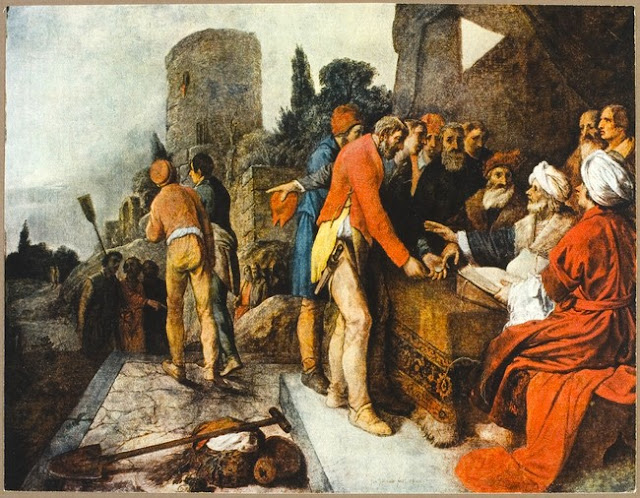 |
| Jan Pynas, The Workers Complain to the Owner of the Vineyard Dutch, 1622 Prague, Narodni Galerie |
 |
| Lambert Jacobszoon, The Workers Complain to the Owner of the Vineyard Dutch, First Half of 17th Century Rouen, Musée des Beaux-Arts |
 |
| Nicolaes Corneliszoon Moeyaert, The Parable of the Workers of the Eleventh Hour Dutch, c. 1630-1640 Chambery, Musée des Beaux-Arts |
 |
| David Collins, The Workers Complain to the Owner of the Vineyard Dutch, First Half of !7th Century Private Collection |
 |
| Salomon Koninck, The Workers Complain to the Owner of the Vineyard Dutch, c. 1645-1650 Saint Petersburg, State Hermitage Museum |
 |
| Jan de Bray, The Vineyard Owner Listens to the Complaint of the Workers Dutch, Second Half of the 17th Century Boston, Museum of Fine Arts |
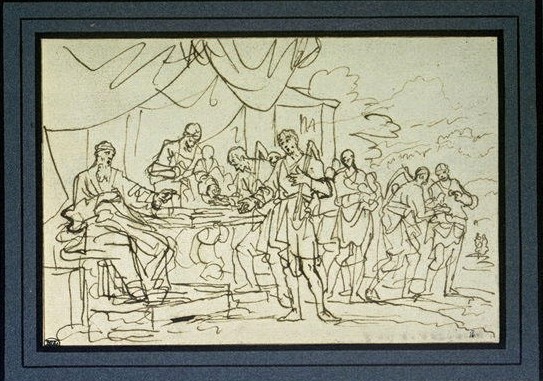 |
| Jan Luyken, The Workers Complain to the Owner of the Vineyard Dutch, c. End of 17th Century Paris, Musée du Louvre, Département des Arts graphiques |
 |
| G. Fremen, The Vineyard Owner Answering the Complaining Workers English, c. 1690 London, The Courtauld |
 |
| John Hall After John Opie, The Lord of the Vineyard From Macklin's Bible English, 1703 London, Trustees of the British Museum |
 |
| Franz Anton Kraus, The Owner of the Vineyard Responds to the Complaining Worker German, c. 1725-1750 Dijon, Musée des Beaux-Arts |
 |
| Christian Wilhelm Ernst Dietrich, The Workers Complain the the Vineyard Owner German, c. 1752 Warsaw, Łazienki Palace |
 |
| Anonymous, The Labourers in the Vineyard British, c. 1770 London, Trustees of the British Museum The text reads "Friend, I do thee no wrong, didst not thou agree with me for a penny?" |
 |
| Marie Angelique Picot After Rembrandt, The Lord of the Vineyard Paying His Labourers English, 1771 London, Trustees of the British Museum |
 |
| Chrstian Bernhard Rode, The Owner of the Vineyard Listens to the Complaints of the Workers German, 1775 Philadelphia, Museum of Art |
 |
| Simon Fokke, The Workers in the Vineyard Dutch, 1791 Amsterdam, Rijksmuseum |
 |
| Anonymous, The Labourers in the Vineyard English, 1803 London, Trustees of the British Museum |
 |
| John Everett Millais, The Labourers in the Vineyard From The Parables of Our Lord English, 1864 London, Tate Collection |
 |
| Charles Ricketts, The Labourers in the Vineyard From The Parables of the Gospel, Vale Press, 1903 English, 1903 London, Trustees of the British Museum |
Jesus Telling the Disciples the Parable
In spite of at least one earlier example, in the sixteenth century there appears to
have been a move to step back from the illustration of the parable story to
take a longer view. In these images
Jesus appears as a narrator, telling his disciples the story or directly addressing
the viewer with the story. This is a
motif that does not appear to have lasted very long.
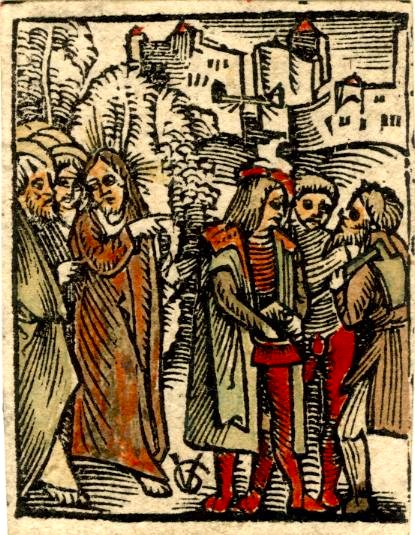 |
| Urs Graf, Jesus Telling the Parable of the Laborers in the Vineyard From Postilla... super Epistolas et Evangelia by Wilhelm of Auvergne Swiss, 1509 London, Trustees of the British Museum |
 |
| Monogrammist HE, Christ Telling His Disciples the Parable of the Laborers in the Vineyard German, c. 1515-1554 Wolfenbuttel, Herzog August Bibliothek |
 |
| Hans Brosamer, Christ Telling His Disciples the Parable of the Laborers in the Vineyard German, c. 1520-1524 London, Trustees of the British Museum |
 |
| Jan Rombouts, The Parable of the Vineyard Dutch, c. 1525-1530 New York, Metropolitan Museum of Art |
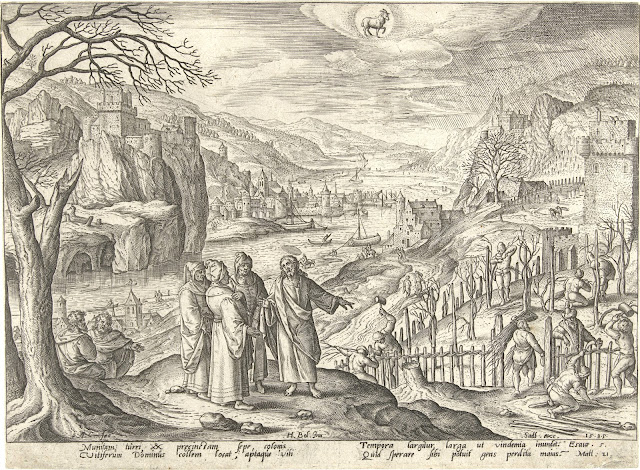 |
| Adriadn Collaert after Hans Bol, April, The Parable of the Workers in the Vineyard Flemish, 1585 Amsterdam, Rijksmuseum |
From the late fifteenth century, with the invention of the printing press, images were primarily spread by
means of prints. It would appear that this
remained the preferred medium until the early seventeenth century, when
painting on canvas began to appear as well.
However, since prints can easily be used as book illustrations, the
printed continued to flourish. And, when
used as book illustrations, the subject returned to the use for which it was
first created.
© M. Duffy, 2023
1. Catalogue entry: Museum Boijmans Van Beuningen, Rotterdam. https://www.boijmans.nl/en/collection/artworks/43978/the-labourers-in-the-vineyard
Excerpts
from the Lectionary for Mass for Use in the Dioceses of the United States of
America, second typical edition © 2001, 1998, 1997, 1986, 1970 Confraternity of
Christian Doctrine, Inc., Washington, DC. Used with permission. All rights
reserved. No portion of this text may be reproduced by any means without
permission in writing from the copyright owner.

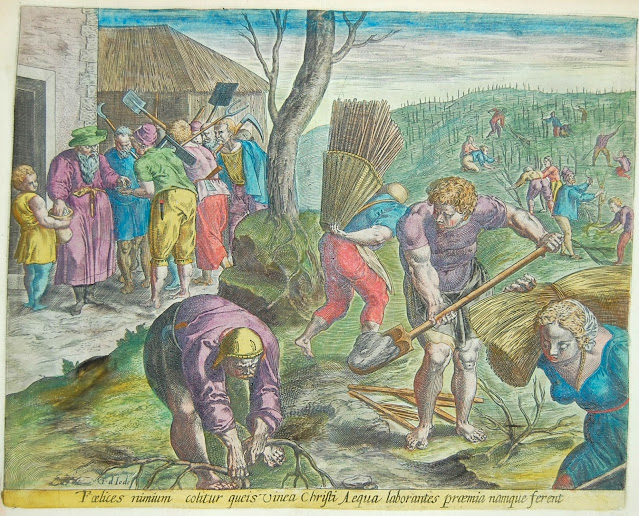


No comments:
Post a Comment